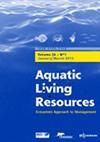新型鱼塘设计对无脊椎动物群落生物多样性和二次生产的影响
IF 1.9
4区 农林科学
Q3 FISHERIES
引用次数: 0
摘要
本研究的目的是比较三种水产养殖生产系统对水生无脊椎动物生物多样性和生产力的影响。我们比较了两种传统的鱼塘设计(粗放型和半集约型)和一种将半集约型鲤鱼混养鱼塘与种植泻湖相结合的新设计,称为耦合半集约型设计。所有鱼塘都放有相同比例的鲤鱼、蟑螂和欧亚鲈鱼。与不提供配方饲料的粗放型池塘相比,半集约化和半集约化池塘的鱼密度增加了一倍。底栖大型无脊椎动物于5月和9月取样。浮游动物从5月到11月每月取样一次。大型底栖无脊椎动物群落的丰富度、生物量、产量和平均个体干质量均高于半集约型、半集约型和粗放型鱼塘。粗放型鱼塘的浮游动物产量最高,半集约型鱼塘的浮游动物产量最低。浮游动物产量在夏季达到高峰,5月和9月低于底栖大型无脊椎动物产量。大型无脊椎动物在泻湖中占主导地位,9月产量高于5月,但在所有鱼塘中几乎没有。最多产的浮游生物类群,特别是在广泛的鱼塘中,在7月和8月达到产量高峰。我们的研究强调了与鱼塘相连的浅水、无鱼、种植泻湖对生物多样性和底栖大型无脊椎动物和浮游动物的生产的功能作用。本文章由计算机程序翻译,如有差异,请以英文原文为准。
Influence of a new fishpond design on invertebrate community biodiversity and secondary production
The aim of this study was to compare the impact of three aquaculture production systems on the biodiversity and productivity of aquatic invertebrates. We compared two conventional fishpond designs (extensive and semi-intensive) with a new design combining a semi-intensive carp polyculture fishpond with a planted lagoon, called coupled semi-intensive design. All fishponds were stocked with the same proportions of common carp, roach, and Eurasian perch. Fish density was double in coupled semi-intensive and semi-intensive ponds compared to extensive ponds for which no formulated feed was provided. Benthic macroinvertebrates were sampled in May and September. Zooplankton was sampled monthly from May to November. For benthic macroinvertebrates, community taxonomic richness, biomass, production, and mean individual dry mass were higher in lagoons than in the coupled semi-intensive, semi-intensive and extensive fishponds. Zooplankton production was highest in extensive fishponds and lowest in coupled semi-intensive ponds. Zooplankton production peaked in summer and was lower than benthic macroinvertebrates production in May and September. Asellus aquaticus, whose production was higher in September than May, was the dominant macroinvertebrate in lagoons, but was almost absent from all fishponds. Bosmina longirostris, the most productive plankton taxon, especially in extensive fishponds, reached peak production in July and August. Our study highlighted the functional role of a shallow, fishless, planted lagoon linked to the fishpond for biodiversity and production of benthic macroinvertebrates and zooplankton.
求助全文
通过发布文献求助,成功后即可免费获取论文全文。
去求助
来源期刊

Aquatic Living Resources
农林科学-海洋与淡水生物学
CiteScore
2.30
自引率
0.00%
发文量
10
审稿时长
>24 weeks
期刊介绍:
Aquatic Living Resources publishes original research papers, review articles and propective notes dealing with all exploited (i.e. fished or farmed) living resources in marine, brackish and freshwater environments.
Priority is given to ecosystem-based approaches to the study of fishery and aquaculture social-ecological systems, including biological, ecological, economic and social dimensions.
Research on the development of interdisciplinary methods and tools which can usefully support the design, implementation and evaluation of alternative management strategies for fisheries and/or aquaculture systems at different scales is particularly welcome by the journal. This includes the exploration of scenarios and strategies for the conservation of aquatic biodiversity and research relating to the development of integrated assessment approaches aimed at ensuring sustainable and high quality uses of aquatic living resources.
 求助内容:
求助内容: 应助结果提醒方式:
应助结果提醒方式:


